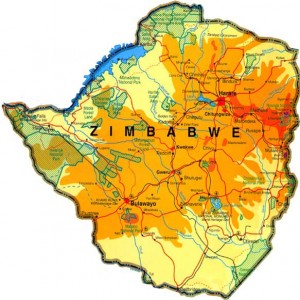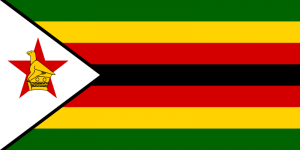“To outsiders, perhaps, Zimbabwe is just a name signifying some random geographical boundaries… But for me it is different. Rhodesia was a forbidden country for me, a white man’s play land…I was always outside looking in…And I did not know until years of bloodshed and turmoil later just how sweet life could be here…I had inhabited Rhodesia, but in Zimbabwe I lived.” – Nozipo Maraire, from Zenzele
Colonization

The British named Rhodesia after the British colonizer and industrialist, Cecil John Rhodes. Rhodes believed that the English had an inherent right to imperial rule because they were the “first race in the world and therefore the more of the world (they) inhabited, the better it would be for the human race” (Nyangoni 19). This ideology of innate British superiority served as justification for their discriminatory colonial policies. In the colony of Rhodesia, the native Africans were ruled by an all-white government in which they were not allowed to participate (See Representation, Nationalism). Only whites were granted the right to vote and elect the leaders governing the land. Laws were passed which prohibited the presence of Africans in many public places. Ordinances structured the inequitable distribution of the land that provided Zimbabwe’s large population of farmers with sustenance. Under these ordinances, 6,000 whites seized the best half of the land while the worst half was left to the 600,000 black peasant farmers (Chung 211). During the colonial rule that extended from 1890 to 1979, the white minority dominated and oppressed the native population and divested them of their land.
Insurrection
Throughout the history of colonial rule, there was much civil unrest among the Zimbabweans. Prior to the revolution, they demanded change only within the limitations of the imperial constitution, calling for equal access to jobs and the right to participate in their government. But beginning in the 1960s, the nationalists‘ vision of freedom became more radical; they now demanded an overthrow of the minority rule if their rights were to be fully recognized. In 1960, the National Democratic Party (NDP) was founded with the goal of achieving African rule by gradual means. Its members demonstrated, rioted and committed acts of arson in hopes of attracting the attention of England and compelling the British to intervene and force a white hand-over of power in Rhodesia (Gann, 42).
The NDP was subsequently banned by the Rhodesian government in 1961 but the group was reconstituted under the name Zimbabwe African People’s Union (ZAPU) in 1962 and led by Joshua Nkomo. ZAPU’s aims and objectives included: 1. The establishment of one-man-one-vote as the basis of government in Zimbabwe. 2. The unification of the African people so as to allow them to liberate themselves from imperialism and colonialism. 3. The elimination of oppression in all forms. 4. The development of the best values in the African tradition to facilitate the establishment of a desirable order (Nyangoni 50). As their ideas became more radical, Africans began to realize that violence and bloodshed was inevitable. The Rhodesians also recognized the revolutionary nature of ZAPU’s goals and banned the group in 1963 so as to avoid conflict.
But ZAPU did not dissolve; it instead went underground. In 1963, internal conflict within the party led to a split and formation of Zimbabwe African National Union (ZANU) under the leadership of Ndabaningi Sithole. The ZANU party shared the same basic goals as ZAPU but they envisioned slightly different means of achieving them. ZANU was in favor of immediate armed confrontation of the enemy and self-reliance while ZAPU was still seeking intervention from the international arena. The split occurred loosely along ethnic lines with the ZANU being more strongly aligned with the Shona and ZAPU with the Ndebele.
As a result of this internal conflict in the independence movement, armed conflict between the two groups and competition for the support of the peasants prevented the Zimbabweans from forming a strong united front of opposition to the Rhodesians. The tactics of guerrilla warfare were employed by both groups beginning in 1964. Their armed resistance to the colonial regime consisted largely of attacks on white farmers and destruction of the property of white settlers. The freedom fighters who performed these acts were recruited from the villages in the rural areas. In the late 1960s, warfare began to decline and members of both ZANU and ZAPU were calling for political and military unity. The early 1970s were characterized by shifting alliances among the nationalists. Opposition to the Rhodesians occurred mostly through political means though some small scale military action did continue through the 70s.
Women’s Role in the Struggle
Zimbabwean women contributed a great deal to their nation’s fight for independence. Traditional gender roles were subverted as many women were recruited as freedom fighters were active participants in the guerrilla warfare. They dressed in fatigues and were often indistinguishable from the men. Women were also essential to the survival of the troops, because they prepared food for them and provided them with clothing. These traditional duties received recognition and earned praise as contributions to the revolution (Gann 101). (See Gender and Nation)
Peace Negotiations
Progress towards a resolution of the conflict in Zimbabwe began with the formation of the Patriotic Front party in 1976. The Patriotic Front represented a unified alliance of the ZANU and ZAPU and was jointly led by Joshua Nkomo (ZAPU’s former president) and Robert Mugabe (an important leader in ZANU). The founding of a single party which represented the interests of the nationalists’ movement for independence facilitated constructive negotiations with the British and Rhodesians.
At the Geneva Conference in 1976, however, the Rhodesians were not yet willing to accept the Zimbabweans’ terms for the negotiation of peace which called for independence by December 1, 1977. Guerrilla warfare was escalated again in 1977-78 because Nkomo and Mugabe felt it was their only means of making the Rhodesians understand the seriousness of their demands. But neither they nor the Rhodesians ever achieved a clear-cut military victory. The conflict was finally resolved at the Lancaster House Conference in England in 1979. It was agreed that free elections would be held in which all parties would be allowed to participate and all people would vote. Under the new government, Zimbabwe was independent of colonial rule. In 1980, Robert Mugabe was elected president of the free nation.

The red star symbolizes the nation’s aspirations. The green stripe represents the country’s vegetation and land resources. The yellow stripe stands for the country’s mineral wealth. The red stripe represents the blood spilled during the liberation struggle. The black stands for the black majority, and the bird is Zimbabwe’s national emblem.
Works Cited
- Chung, Fay. “Education with production before and after independence.”pp. 211-224. Turmoil and Tenacity. ed. Banana, Canaan S. Harare: The College Press, Ltd., 1989.
- Gann, Lewis. The Struggle for Zimbabwe. New York: Praeger Publishers,1981.
- Nyangoni, Wellington. African Nationalism in Zimbabwe. Washington D.C.: University Press of America, 1978.
Selected Bibliography
- Kesby, M. “Arenas for Control, Terrains of Gender Contestation; Guerrilla Struggle and Counter-Insurgency Warfare in Zimbabwe 1972-80.” Journal of Southern African Studies 22.4 (1996): 561-584.
- Kesby, M. “Locating and Dislocating Gender in Rural Zimbabwe; Making Spaces and Texturing Bodies.” Gender, Place and Culture 6.1(1999): 27-47.
- Kriger, Norma. Zimbabwe’s Guerrilla War: Peasant Voices. Cambridge: Cambridge University Press, 1992.
- Staunton, Irene. Mothers of the Revolution. Bloomington, Indiana: Indiana University Press, 1990.
Author: Alison M. Ray, Fall 1997
Last edited: October 2017
5 Comments
Pingback: “It is homeland or death”: From British colonialism to Zimbabwean liberation war – The Leftist Critic
Pingback: “It is homeland or death”: Final days of Zimbabwe’s liberation war and post-independence – The Leftist Critic
Pingback: On the Sound of Reggae – A Signal of Rasta – The Social Philosopher
What are some examples of Zimbabwe resisting to the colonizers?
Example ( hunger strike)…
THE MAJOR ONE IS THE FIGHT FOR THEIR LAND